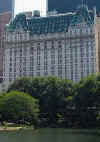 |
New York
Architecture Images- Midtown The Plaza Hotel |
|
architect |
Henry J Hardenbergh |
|
location |
Grand Army Plaza, Fifth Ave at 59th St. |
|
date |
1909 |
|
style |
Second Empire Baroque late medieval French chateau |
|
construction |
|
|
type |
Hotel |
|
|
 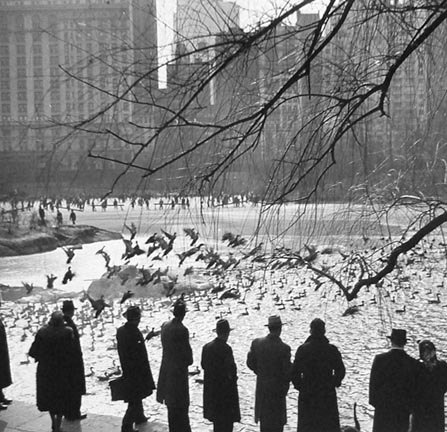 |
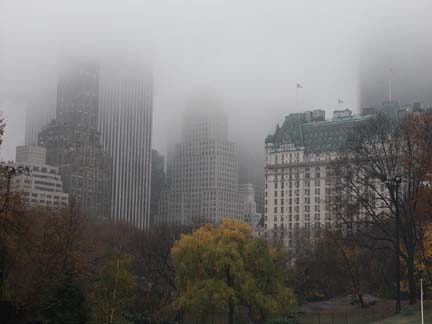 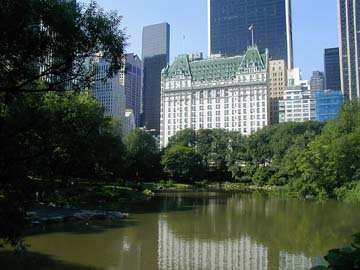 |
|
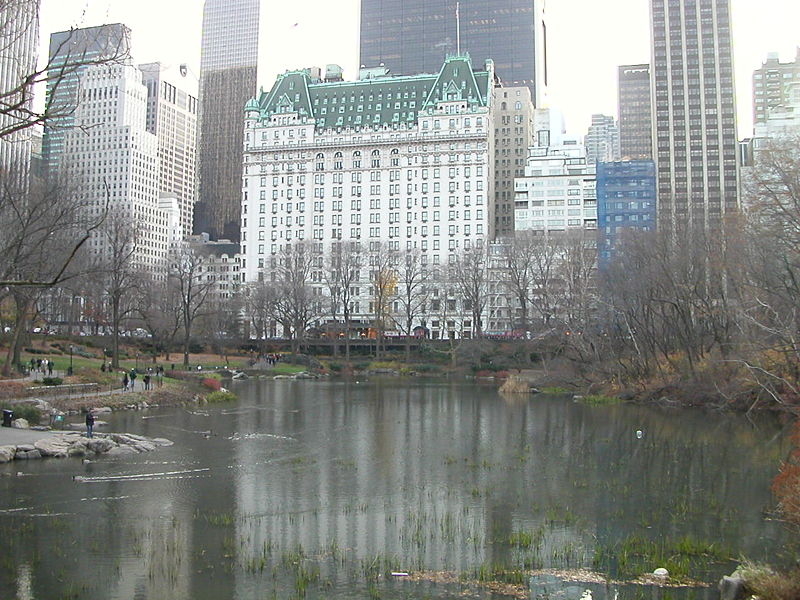 |
|
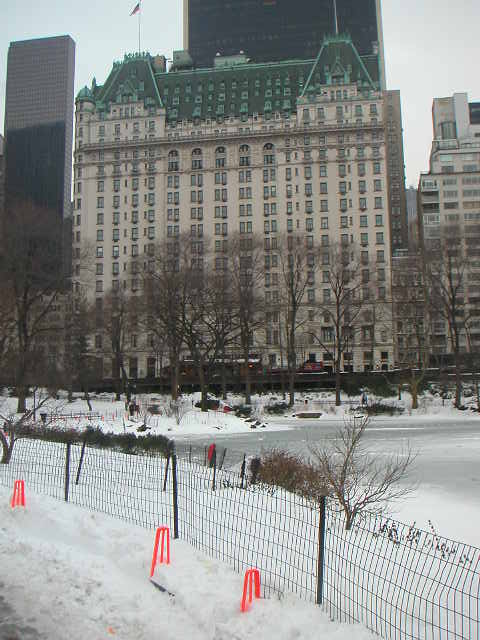 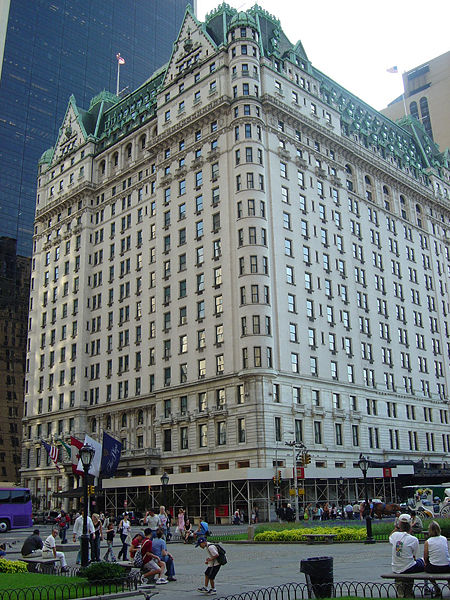 |
|
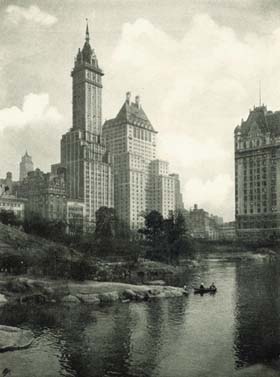 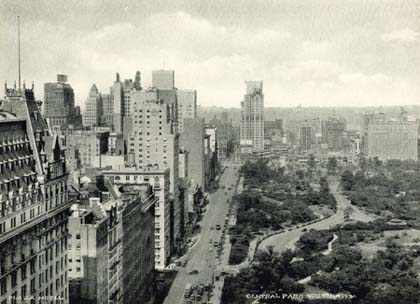 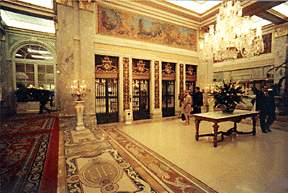 |
|
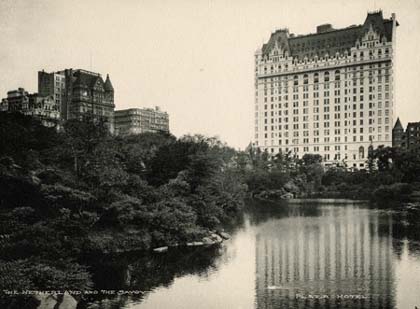 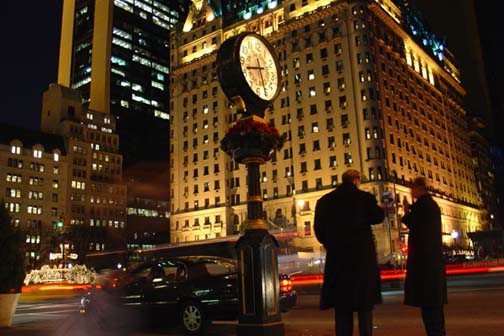 |
|
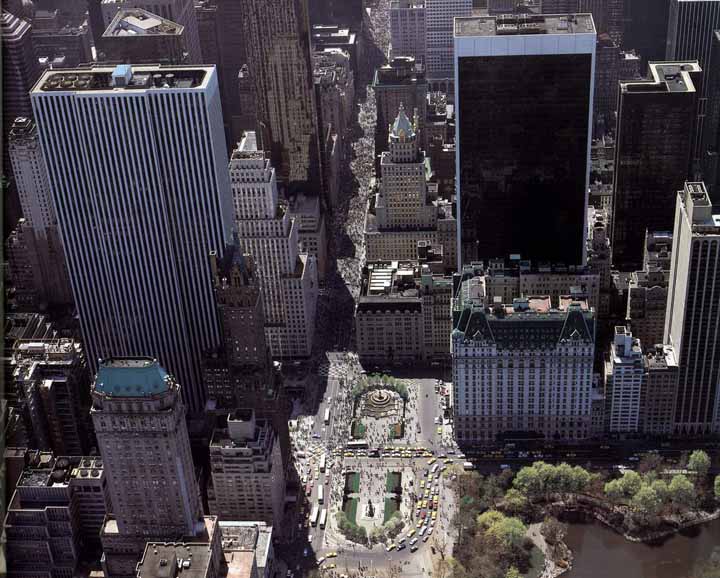 |
|
|
images |
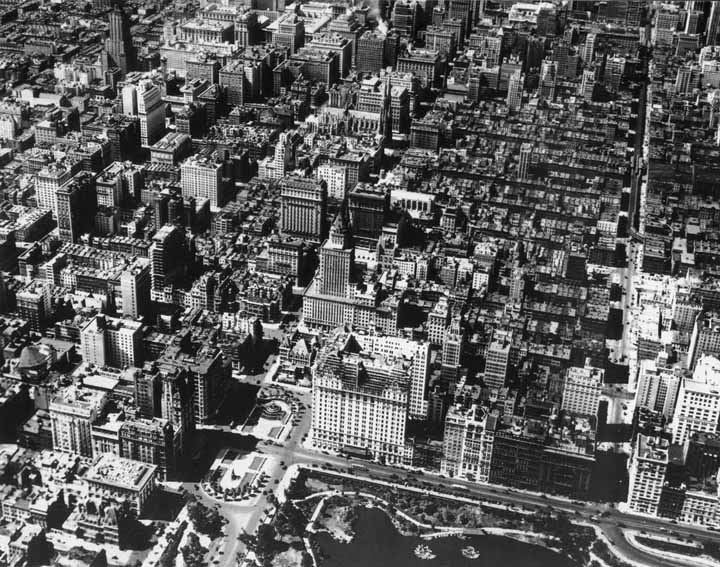 |
|
|
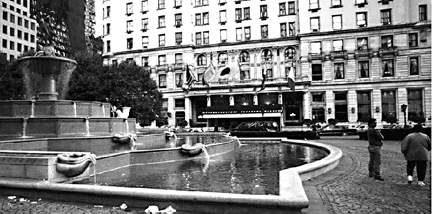 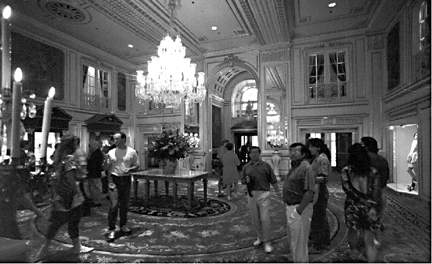 |
 |
|
|
The Plaza Hotel in New York City is a landmark 19-story luxury hotel with
a height of 250 feet (76 m) and length of 400 feet that (122 m) occupies
the west side of Grand Army Plaza, from which it derives its name, and
extends along Central Park South in Manhattan. Fifth Avenue extends
along the east side of Grand Army Plaza. Grand Army Plaza The hotel's main entrance faces the southern portion of Grand Army Plaza— commemorating the Union Army in the Civil War. Grand Army Plaza is in two sections, bisected by Central Park South. The section in front of the Plaza Hotel is centered by the Pulitzer Fountain, of Abundance by Karl Bitter, funded by the will of the newspaper publisher Joseph Pulitzer: the statue in the fountain is actually Pomona, Roman goddess of orchards. The north side of Grand Army Plaza, a cutout from Central Park, has the glorious Augustus Saint-Gaudens part-gilded bronze equestrian statue of General Sherman. Grand Army Plaza provided the original main entrance to the carriage drives of Central Park. On the south side of the Plaza (between 58th and 59th Streets) once stood the French Renaissance château of Cornelius Vanderbilt II, designed by George Browne Post; rising behind its gated front court, it was the grandest of the Fifth Avenue mansions of the Gilded Age. Bergdorf Goodman occupies its site. The Plaza Hotel The Plaza is the second hotel of that name on the site. The French Renaissance château-style building was designed by Henry Janeway Hardenbergh and opened to the public October 1, 1907. Originally the Plaza cost $12.5 million to build in 1907. The Plaza was accorded landmark status by the New York City Landmarks Preservation Commission in 1988 and is, with the Waldorf-Astoria, the only New York City hotel to be designated as a National Historic Landmark. In the 1950s it was the setting for Kay Thompson's series of Eloise books, Eartha Kitt and Peggy Lee played the Persian Room, unaccompanied ladies were not permitted in the Oak Room bar and the Palm Court was favored for luncheons and teas. The Beatles stayed at the Plaza during their first visit to the United States in February, 1964. On November 28, 1966, in honor of publisher Katharine Graham, Truman Capote hosted his acclaimed "Black & White Ball" in the Grand Ballroom. In September 1985, the Plaza Accord was signed at the Plaza. The Accord served as an agreement among the finance ministers of the United States, Japan, West Germany, France and Britain to bring down the price of the U.S. dollar against their currencies. The building was declared a National Historic Landmark in 1986.[1],[3],[4] Ownership changes and renovations Conrad Hilton bought the Plaza for $7.4 million in 1943 and spent $6.0 million to refurbish the original. Hilton called the Plaza the smartest hotel in America. Hilton later sold the Plaza when he bought the Waldorf-Astoria. Donald Trump bought the Plaza for $407.5 million in 1988. Trump commented on his purchase in a full-page open letter he had published in The New York Times: I haven't purchased a building, I have purchased a masterpiece — the Mona Lisa. For the first time in my life, I have knowingly made a deal that was not economic — for I can never justify the price I paid, no matter how successful the Plaza becomes. Trump sold the hotel for $325 million in 1995 to a partnership between Prince Alwaleed Bin Talal Bin Abdulaziz Al Saud and Millennium & Copthorne Hotels. It was sold again in 2004 for $675 million to a Manhattan developer, El Ad Properties. El Ad closed The Plaza on April 30, 2005, to undergo extensive renovations. It is planned to reopen on December 3, 2007. When the renovations are complete, the Plaza is expected to offer 130 hotel rooms and 152 private condo hotel units and be managed by Fairmont Hotels and Resorts. In May 2007, a new apartment in the Plaza was sold for a record $50 Million.[1] Movie backdrop Although the hotel had appeared briefly in earlier films, it made its major movie debut in the 1959 film North by Northwest. It was also a setting for Barefoot in the Park (1967), Funny Girl (1968), Plaza Suite (1971), The Way We Were (1973), Love at First Bite (1979), Arthur (1981), Cotton Club (1984), the first two Crocodile Dundee movies, Big Business (1988), King of New York (1990), Home Alone 2: Lost in New York (1992), It Could Happen to You (1994), Almost Famous (2000), and Inside the Osmonds (2001), and several episodes of The Sopranos (most notably "The Test Dream," Season 5, Episode 11) feature scenes occurring in a suite at the Plaza. Then-Plaza owner Donald Trump appears in Home Alone 2: Lost in New York, directing the main character Kevin to the lobby. The book Eloise at the Plaza and its film adaptations are set here as well. The Plaza featured notably in the original 1956 Eloise TV movie starring Evelyn Rudie as Eloise, the child who lived "on the top floor", with cameo appearances by Conrad Hilton and Eloise author Kay Thompson. The Plaza was featured in the movie "Eloise at Christmastime" starring Julie Andrews. The Plaza was frequently featured in Friends. The Plaza is also featured throughout the popular TV series Sex and the City, as a backdrop for Mr. Big's (Chris Noth) engagement party and a variety of other scenes. The Plaza was featured in a few openings of the daytime soap opera Ryan's Hope. The Plaza was also the venue for Becky Bloomwood's faux wedding in Shopaholic Ties The Knot by Sophie Kinsella. Future of the Plaza Brand The El Ad Group, which owns the New York Plaza Hotel, plans to expand the "Plaza" brand name with new luxury hotels in the top cities of the world such as London, Los Angeles, Boston, San Francisco, Rome and Washington, D.C. The first of these new Plaza's was announced, on May 16, 2007, as the Las Vegas Plaza ; a $5 Billion multi-use ultra-luxury hotel, private residence, retail and gaming complex to be developed on the Las Vegas Strip opposite Wynn Las Vegas. Construction will begin in early 2008 and is expected to be completed in 2011[2]. References and Sources ^ a b Plaza Hotel. National Historic Landmark summary listing. National Park Service (2007-09-18). ^ National Register Information System. National Register of Historic Places. National Park Service (2006-03-15). ^ ["Plaza Hotel", undated, by Carolyn PittsPDF (810 KiB) National Register of Historic Places Inventory-Nomination]. National Park Service (undated). ^ [Plaza Hotel--Accompanying 4 photos, exterior and interior, from 1982.PDF (758 KiB) National Register of Historic Places Inventory-Nomination]. National Park Service (undated). amNew York Interactive report on The Plaza The WPA Guide to New York City, 1939 (reprinted 1982) (ISBN 0-394-71215-3) Ward Morehouse III, Life at the Top |
|
|
HISTORY The Plaza was originally built in 1900 and then was rebuilt in 1907 to the tune of twelve million dollars when the new Ritz Carlton joined the other hotels at the turn of the century. The hotel brought elegance east of Fifth street. "The opening of the Plaza Hotel was accompanied by the sure sign of the automobile on Fifth avenue in New York." "The Plaza has been able to maintain its standings over the years. The Plaza's various public rooms have undergone numerous incarnations. The large room on the corner of Forty-ninth Street and the Plaza, which was called simply the "restaurant," assumed various decors as the Edwardian Room and the Green Tulop, and the Fifty-ninth Street dining room that served as the office of Jules Bache has become, and Remains, the Oak Room." "Finally, the Plaza houses New York's one functioning Palm Court, and it has a busy day. Breakfasts and salad lunches are served, and no sooner are the last leaves of lettuce carried away than a violinist and pianist turn up and a flame is put under the tea kittles and cocoa in the kitchens. This does not mean, however, that the Plaza has not plugged ahead into the future. Not only does it provide its guests with closed circuit television and choice of two movies daily, but troubleshooting hostesses called "service coordinators," together speaking all of fifteen languages, patrol the lobby and halls where once private maids and lackies scurried obediently." ARCHITECTURE The Plaza Hotel, one of New York city's finest hotels, was architecturally designed imitating the style of a late medieval French chateaux. The elegant lobby contains ornamented archways, pillars, and marble floors. This combined with a usage of the color gold give the hotel a wealthy, upper-class appearance. WORKS CITED Batterberry, Michael and Ariane. On The Town In New York. New York: Charles Scribner's Sons, 1973. By: Alexandra Chiurri Chiurri@Murray.Fordham.edu and Giannina Ortiz Gortiz@Murray.Fordham.edu |
|
|
Newsday August 13, 2004 Plaza Hotel to be sold in $675M deal Associated Press The Plaza Hotel is shown August 11, 2004 in New York City. British firm Millennium & Copthorne sold its stake New York's Plaza Hotel in a $675 million deal on August 13, 2004. Millennium & Copthorne was not the full owner but held a 50 percent stake in Plaza Operating Partners which is selling it on to U.S. property firm El Ad Properties NY LLC. The other 50 percent of Plaza Operating Partners is owned by Saudi Prince Alwaleed bin Talal. LONDON -- The owners of New York's struggling Plaza Hotel are selling it to a U.S. investment group in a $675 million cash deal. International hotel group Millennium & Copthorne said Friday that Plaza Operating Partners, in which it has a 50 percent stake, has agreed to sell the prestigious but underperforming hotel to CPS One, an affiliate of U.S. property investment group El Ad Properties. The transaction includes the adjoining property on Fifth Avenue. The other 50 percent of Plaza Operating Partners is owned by Saudi Prince Alwaleed bin Talal, but it was not immediately clear if the $675 million would be split evenly between the two stakeholders. The deal is expected to close by the end of the year. Millennium & Copthorne said it would use sale proceeds to reduce debt. The group, which operates almost 100 four-star and five-star hotels in 16 countries, said last week that its outlook is improving after a sharp fall in profitability last year linked to the SARS crisis and the Iraq war. Copyright © 2004 Newsday, Inc. ------------------------- August 14, 2004 Eloise Gets a New Landlord: Plaza Sells for $675 Million By JAMES BARRON An Israeli developer is buying the Plaza, celebrated in fact and fiction, for a record price per room. The Plaza Hotel, where F. Scott and Zelda Fitzgerald pranced in the fountain and Eloise burbled "Oooooooo, I absolutely love the Plaza" as she pranced through the corridors, is being sold to the New York unit of an Israeli developer for $675 million. The Plaza's new owner (and thus the new landlord of Eloise, the fictional 6-year-old heroine of the children's books by Kay Thompson and Hilary Knight) is Elad Properties. While the price is not a record for a hotel in New York, the per-room price - a measure analysts routinely calculate - is, said Sean Hennessey, who follows the New York hotel market for Lodging Investment Advisers, a consulting firm. Elad is paying $838,509 a room, a sign, Mr. Hennessey said, that the hotel market is rebounding from the Sept. 11 terror attacks. He said that room rates for hotels in New York had risen 9 percent this year, far outpacing inflation. "The operating fundamentals are improving," he said, "so there have been a lot of investors and sellers who were sitting on the sidelines in the downturn that followed 9/11, waiting for market conditions to firm up enough to put their properties up for sale or jump in and buy them." Since 1995, the Plaza has been owned by one of the world's wealthiest men, Prince Alwaleed bin Talal bin Abdul Aziz Alsaud of Saudi Arabia, and Millennium & Copthorne, a London-based company that runs hotels in 16 countries. The prince, a nephew of King Fahd, made headlines after the Sept. 11 attacks when he offered to donate $10 million to the City of New York, and Rudolph W. Giuliani, the mayor at the time, accepted but then returned the check. Mr. Giuliani sent the check back after learning that in a news release, the prince had criticized the American government's policies in the Middle East. The prince and Millennium & Copthorne paid Donald J. Trump $325 million and spent $40 million on renovations. But based on figures from Millennium & Copthorne, the Plaza had a pretax loss of $1.8 million last year. "It's an icon, but the price is too good to refuse," Kwek Leng Beng, the chairman of Millennium & Copthorne, said at a news conference in Singapore, according to Bloomberg News. "The prince is very happy - he's invited me to Paris, where he wants to give me a big dinner." Miki Naftali, president and chief executive of Elad Properties, issued a statement through a spokesman, who declined to discuss Elad's plans for the Plaza. A real estate executive who had been briefed on the deal said Elad was considering turning some of the Plaza's 805 rooms into condominiums. Mr. Trump talked about the same idea when he controlled the Plaza in the early 1990's. He said at the time that condominiums would not turn the turreted French Renaissance landmark into the Manhattan version of a time-share in the Catskills, though some architectural historians called the plan heresy. "The flavor of the project is similar to what Trump had in mind," the executive who had been briefed on the deal said. "It's going to be a high-end condominium with hotel services." Elad has built condominiums in a couple of other buildings it has renovated in New York recently: one a former United Federation of Teachers office building on East 21st Street near Gramercy Park, another the old Mercantile Library building at Astor Place and Broadway. For his part, Mr. Kwek said the Plaza still needed work. "The hotel needs renovation, and I don't want to spend any more money on it," Mr. Kwek was quoted as saying. He said that in its best year, 2000, the Plaza had a profit of $45 million. Copyright 2004 The New York Times Company --------------------- PLAZA TO SHUT FOR MAKEOVER January 17, 2005 -- Better call the Waldorf, Eloise! — The Plaza will be shut down this May for extensive renovations, a new report says. "Inquiries about booking special events at the hotel after April are answered with a cautionary warning," according to Crain's New York Business. "The catering department is advising people not to plan parties at The Plaza for May and beyond." Early next month, the famous hotel will shutter its historic Oak Room and Oyster Bar restaurants. As The Post has reported, Elad Properties, which now owns the hotel, plans to turn The Plaza's top floors into condos. But it's expected that some hotel rooms will still be available. It's not clear when the hotel will reopen. Bill Hoffmann Copyright 2005 NYP Holdings, Inc --------------------- The 838G suite! Plaza sold & will go part-condo BY LORE CROGHAN DAILY NEWS BUSINESS WRITER http://www.nydailynews.com/news/local/story/221954p-190746c.html $675M price tag for landmark Plaza Hotel (lower l.) means new owner’s paying highest price per room in city history. There's room for change at The Plaza: A Saudi prince is selling the hotel to an Israeli company that is expected to convert some rooms to pricey apartments. Prince Alwaleed Bin Talal, the fourth-richest man in the world, is unloading the Fifth Ave. landmark for the royal sum of $675 million. That comes out to $838,000 per room, the highest ever for a New York City hotel. It's worth it, analysts said. "What better address to have than The Plaza's?" said Sean Hennessey of Lodging Investment Advisors. "This is a landmark with international recognition. You'd go there because it's a place you'd seen in a movie." Visitors might remember it from "Plaza Suite," "North by Northwest," "The Great Gatsby" or "The Way We Were." Little girls still clamor to have tea in the Palm Court like the fictional Eloise who lived in the hotel. The new buyer, Elad Properties, is an American arm of Elad Hotels Ltd., which owns hotels throughout Israel. Because The Plaza has 805 rooms - instead of the 200 to 400 in the typical luxury hotel - it has never been able to charge top dollar. Turning some of its rooms into apartments will give the hotel, which lost $1.8 million last year, a needed boost to the bottom line, according to the plan. The condos are expected to command $2,000 per square foot, industry insiders said. Prior owner Donald Trump had similar conversion plans but never carried them out. The megamogul sold The Plaza for $325 million in 1995 to the Saudi prince and a partner, Millennium & Copthorne Hotels. Elad Properties is considered the right firm to take part of the hotel condo. Elad is known in Manhattan not as a hotelier but as a skilled converter of old buildings into elegant apartments, such as 21 Astor Place. Besides making a bundle on apartment sales, Elad will be able to raise hotel rates once some of the rooms are taken out of service, said Hennessey, the hotel analyst. Though Bin Talal is selling the property - at Fifth and Central Park South - he'll continue to own some important pieces of New York. He is the largest shareholder of Manhattan-based Citigroup. And he has a stake in Four Seasons Hotels - whose famous Manhattan property is just a few blocks from The Plaza. Originally published on August 14, 2004 --------------------- PLAZA'S GOING RETAIL By HILARY KRAMER January 23, 2005 The Plaza hotel is looking for high-end boutiques like Versace and specialty food shops like Zabar's — as well as a hotel management company — as it transforms itself into a condo/retail center. A source close to the historic hotel's operators say The Plaza has approached specialty food shops about moving into the space previously occupied by the Oak Room restaurant. The owners also want a designer shop for the ground floor. "It's too small for a big department store and it's a landmarked building, so big windows can't be created on the façade," the source said. "It must be a destination store . . . we may even see a spa or entertainment." Once home to Vanderbilts and Hitchcocks, the 98-year-old hotel will shut its doors for 18 to 24 months on April 30, after which the building will be remodeled into condominiums and retail space. Only about 80 of The Plaza's 805 rooms will remain as a hotel. The makeover is the brainchild of reclusive Israeli billionaire Yitzhak Tshuva, who bought the Plaza for $675 million last year. The hotel has lost money since the World Trade Center attacks, but Tshuva is willing to sit on his investment — since a one-bedroom condo in the building could fetch as much as $3 million. There's no shortage of interest. The Israeli newspaper Haaretz reported Tshuva had spoken to celebrities like John Travolta about buying a unit. "The Plaza will fly big time for those wanting pied-a-terres and apartments in the best location," says William Costigan, a high-end broker who just sold a $12 million apartment on Central Park. "The Europeans are able to buy here for less. You are buying a piece of New York history. There a several rooms in there that are gems." Hotel companies — Starwood, Marriott, CNL Hospitality Properties and Interstate among them — are less enthusiastic. Although they would provide service to the whole building, including condos, they want at least some high-end rooms that face Central Park. A source says Tshuva and his company want most of those spaces for permanent tenants. Tshuva wants a deal soon, and hopes to get construction rolling as soon as the last suitcase is out the door. "He is looking to do this fast and is under pressure to go to market as quickly as possible, because although the market is good for luxury condos now, there's no telling how long that will last," said Peter Slatin, of the real-estate newsletter the Slatin Report. "He wants to beat others and is on track to beat the developers of the Mayflower Hotel on Central Park West." Tshuva, a scruffy Israeli refugee turned real-estate mogul, is expanding his holdings in the United States. He bought the 32-story BellSouth building in Jacksonville, Fla., for $91 million, The Gift Building at 225 Fifth Ave. for $125 million and converted 21 Astor Place to condominiums. But Tshuva is facing resistance from those who want the storied hotel to remain unchanged. In answer to these critics, his company's CEO, the savvy Miki Naftali, has mounted a publicity campaign to convince residents that remaking The Plaza's interior — while retaining its French Renaissance exterior — is the best way to save it. Tshuva actually has history on his side. When The Plaza opened in 1907, it was used primarily as a residence for wealthy New Yorkers such as Alfred Vanderbilt. The famous flocked to its doors. Alfred Hitchcock shot parts of "North by Northwest" there, and it was the site of the Catherine Zeta-Jones/Michael Douglas wedding reception. Ernest Hemingway once counseled F. Scott Fitzgerald that he should leave his liver to Princeton and his heart to The Plaza. Just don't forget your luggage — after April 30, you probably won't get it back. Copyright 2005 NYP Holdings, Inc. ------------------------------------- Condos and Stores Planned for Plaza By JAMES BARRON The Plaza Hotel, which will close for changes by April 30, was bought by an Israeli developer for $675 million last fall. The Plaza Hotel, where F. Scott Fitzgerald drank and Alfred Hitchcock directed and Truman Capote held sway and Eloise romped, will close by April 30 to be divided into three parts - condominiums, stores and a much smaller hotel. Confirming rumors that had swirled in real estate circles for months, the real estate developer who bought the Plaza last fall said yesterday that the 805-room hotel would be turned into a multipurpose building. The developer, Miki Naftali, president and chief executive of Elad Properties, said he was planning 200 one- to four-bedroom condos, mainly on the Plaza's upper floors, facing Fifth Avenue and Central Park South. He said that a hotel with 150 rooms, just under a fifth the number the Plaza has now, would occupy much of the 58th Street side of the building. The ornate Grand Ballroom and the multilevel Terrace Room - where countless cocktail parties and galas and wedding receptions have been held over the years - would be turned into space for stores. Two subbasement levels will also be renovated for retailers, he said. But some of the Plaza's most visible and venerable public spaces will reopen after being given nothing more than what he called cosmetic touchups: the Palm Court, the airy centerpiece of the lobby; the restaurant at the building's northeast corner that was long known as the Edwardian Room (and closed after being renamed One CPS); and the Oak Room and the Oak Bar, with their dark-paneled walls. But the restaurants will be operated separately from the hotel and are likely to be turned over to outside restaurateurs. Mr. Naftali's company, which is owned by Yitzhak Tshuva, an Israeli developer, paid $675 million for the Plaza. Mr. Naftali said the renovation would cost at least $100 million. The Plaza's fortresslike exterior was designated a city landmark in 1969. Its interior has never been given landmark status. "It's not that we feel we're restricted" because it has landmark status, Mr. Naftali said, "we can't think of changing it. I don't need to put huge signage on the building to call people to come in." Officials of the city's Landmarks Preservation Commission said that any interior designation would have covered only the public spaces - not the individual rooms, which Mr. Naftali and his architects want to combine to make larger apartments in the condominium. The developer's team also envisions relocating bathrooms and installing kitchens, although he said that one reason to live there would be to order takeout meals from the restaurants in the lobby. "Our plan is to keep the integrity of the spaces," Mr. Naftali said. "The challenge is to refresh the space." He said that the Plaza, which opened in 1907, was "worn down" and needed to be brought up to modern standards. "It's amazing people think it's one of the best hotels in the world," he said. "It's not. But look at the space." Mr. Naftali said the renovations would begin as soon as the Plaza closes and the employees are laid off. He said the hotel had already given 60 days' notice to 176 workers in the Oak Room, the Oyster Bar and adjacent kitchen areas. The hotel's 800 or so other employees will receive formal notification, as required by the Plaza's contract with the hotel workers union, by the end of February. But Mr. Naftali said managers had already begun telling those workers that the hotel would shut down in the spring. Peter Ward, president of the New York Hotel and Motel Trades Council, said he had met with Mr. Naftali and was concerned about the loss of so many jobs. "We're working toward resolution of an exit agreement," Mr. Ward said. As Mr. Naftali sees it, the Plaza's registration area, on the Central Park South side of the first floor, will serve as the entrance to the condos. The new hotel will be reached from the Rose Room, a high-ceilinged space that once housed a nightclub off the hotel's Fifth Avenue lobby. "When you walk through the Plaza and you see so many gorgeous rooms," Mr. Naftali said, "we thought, 'how could we convert those spaces to residential?' We are keeping the integrity of those famous rooms." Robert B. Tierney, chairman of the Landmarks Commission, said that part of Mr. Naftali's plan for the building "raises enough questions that we'd have to take a look at it." Copyright 2005 The New York Times Company |
|